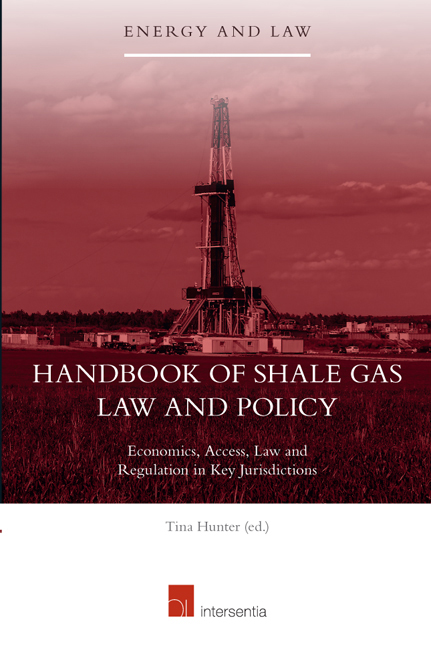Book contents
- Frontmatter
- Preface
- Contents
- List of Tables and Figures
- List of Authors
- Part I Overview and Introduction to Shale Gas Activities
- Part II Shale Gas Economics and Energy Security
- The US Shale Gas Revolution and its Economic Impacts in the Non-US Setting: A Russian Perspective
- Shale Gas and Global Markets
- Shale Gas and Energy Security
- Part III Access to Shale Gas Resources
- Part IV Shale Gas Law and Regulation
- Part V The Future of Shale Gas in the United Kingdom
- Index
Shale Gas and Energy Security
from Part II - Shale Gas Economics and Energy Security
Published online by Cambridge University Press: 21 September 2018
- Frontmatter
- Preface
- Contents
- List of Tables and Figures
- List of Authors
- Part I Overview and Introduction to Shale Gas Activities
- Part II Shale Gas Economics and Energy Security
- The US Shale Gas Revolution and its Economic Impacts in the Non-US Setting: A Russian Perspective
- Shale Gas and Global Markets
- Shale Gas and Energy Security
- Part III Access to Shale Gas Resources
- Part IV Shale Gas Law and Regulation
- Part V The Future of Shale Gas in the United Kingdom
- Index
Summary
Energy security has traditionally been built around three factors: security of supply, price, and environmental sustainability. Traditionally linked to crude oil, with change of consumption patterns, rise of geopolitical factors and longterm challenges of climate change, energy security can be seen as a ‘healthy’ balance of energy mix that developed economies are increasingly longing for. Globally, natural gas is an emerging fuel the economics of which is still largely dependent on trade in crude oil and petroleum products. The link between oil and gas dates back to the early days of conventional oil production where gas was a by-product of crude exploration flared on the spot to access the black gold underground. The unique link established a basis for pricing and trading natural gas as a fuel indexed to crude oil and its derivatives. While it is still flared in some remote production regions, for aff ordability and environmental reasons natural gas is becoming increasingly too precious to be left behind. In particular, environmental concerns, particularly the move towards having a lower carbon footprint, and the applicability of natural gas as an aff ordable source to fuel industry and provide energy and heating source to households have all caused natural gas to oft en be described as a fuel of choice, a term that reconciles interests of businesses, the energy industry and communities. While production of natural gas from conventional geologies continues, technological and geological progress is now changing the ‘old’ way of thinking about gas and energy security by adding shale gas to the equation. Despite its trading structure being by all means not yet global and largely confined to regional and international markets in search for demand, shale gas has already managed to change perceptions of the geopolitics of energy security globally. Due to the rise of new technologies of extraction, gas is oft en presented as a bridging fuel between the ‘traditional’ high-carbon energy carriers such as coal and crude oil and the future, where low-carbon energy sources, in particular renewable energy, will become more prevalent.
The bridging or transition period between the two has provided the momentum to shape the move from the ‘old’ sources of energy security to the ‘new’.
- Type
- Chapter
- Information
- Handbook of Shale Gas Law and PolicyEconomics, Access, Law and Regulation in Key Jurisdictions, pp. 123 - 136Publisher: IntersentiaPrint publication year: 2016



